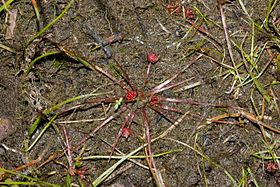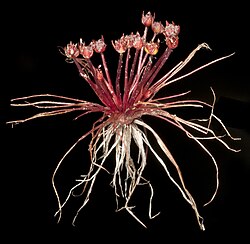Trithuria

| Trithuria | |||||||||||||
|---|---|---|---|---|---|---|---|---|---|---|---|---|---|
| Classificação científica | |||||||||||||
| |||||||||||||
| Espécie-tipo | |||||||||||||
| Trithuria submersa Hook.f. | |||||||||||||
| Espécies | |||||||||||||
Ver texto. | |||||||||||||
| Sinónimos | |||||||||||||
| |||||||||||||

Trithuria é um género de pequenas herbáceas aquáticas pertencentes à família das hidateláceas. Recentemente, o género Hydatella foi incluído em Trithuria. O género é nativo da Índia, Austrália e Nova Zelândia e inclui 12-13 espécies descritas e aceites.[3]
Descrição
[editar | editar código-fonte]Trithuria é um género de pequenas aquáticas efémeras herbácea que representam os únicos membros da família Hydatellaceae encontrados na Índia, Austrália e Nova Zelândia.[4][5] Todas as 13 espécies formalmente caracterizadas de Trithuria encontram-se na Austrália, com exceção de T. inconspicua e T. konkanensis, que se encontram na Nova Zelândia e na Índia, respetivamente.[6][7]
São plantas aquáticas minúsculas, com aspecto graminoide ou juncoide. Apesar da sua morfologia, são os parentes vivos mais próximos dos nenúfares e plantas aquáticas similares.[8][9] Na realidade, estas plantas aquáticas diminutas, superficialmente semelhantes a musgos, são os parentes vivos mais próximos de um clado que inclui duas famílias de nenúfares intimamente relacionadas, as Nymphaeaceae e as Cabombaceae.[10]
Em conjunto, estas três famílias compõem a ordem Nymphaeales no sistema APG IV de classificação das plantas com flor. O género Trithuria (Hydatellaceae) divergiu do resto de Nymphaeales logo após o agrupamento Nymphaeales ter divergido de seu táxon irmão, embora o clado coroa tenha evoluído relativamente recentemente, no início do Mioceno (~19 Ma;[11]). A ordem como um todo é o grupo irmão de todas as plantas com flor, exceto Amborellales.
Até que os dados da sua sequenciação genética e uma reinterpretação da morfologia provassem o contrário, acreditava-se que essas plantas eram monocotiledóneas filogeneticamente próximas das gramíneas (Poaceae). São as únicas plantas, para além de dois membros de Triuridaceae (Lacandonia schizmatica e Lacandonia braziliana), em que os estames estão no centro da flor enquanto os pistilos os rodeiam. Nas Hydatellaceae as 'flores' resultantes podem representar inflorescências condensadas ou não-flores.[12]
Devido a evolução convergente, o género Trithuria apresenta uma semelhança notável com o género Centrolepis e as espécies de ambos os géneros foram confundidas com membros do outro género.[13]
O número cromossómico (diploide) de Trithuria inconspicua subsp. inconspicua é 2n = c. 24. O número cromossómico de Trithuria submersa é 2n = 56.[14] O número de cromossomas da espécie tetraploide Trithuria konkanensis é 2n = 40.[15] O número cromossómico de Trithuria australis é 2n = 14.[16]
Taxonomia
[editar | editar código-fonte]O género foi descrito por Joseph Dalton Hooker e publicado em Flora Tasmaniae 2: 78. 1858.[17] A espécie tipo é Trithuria submersa Hook.f. A etimologia do nome genérico Trithuria é composta por duas partes: as palavras gregas treis, que significa "três", e thyris, que significa "janela", uma referência à forma de deiscência do fruto.[18] Especificamente, refere-se às válvulas do pericarpo de algumas espécies de Trithuria.[14]
O género Hydatella foi incluído em Trithuria uma vez que os seus membros estão filogeneticamente aninhados nele. A família como um todo partilha as seguintes características morfológicas e sinapomorfias:[6][19]
- Ausência de um câmbio vascular;
- Ausência de esclerênquima pericíclico;
- Estomas anomocíticos;
- Conectivo da antera truncado;
- Pólen em forma de barco;
- Tegumento interno com duas camadas de células;
- Exotesta paliçada;
- Opérculo da semente formado pelo aumento de células no tegumento interno;
- Perisperma;
- Germinação hipogénea.
As espécies da família eram anteriormente classificadas na família Centrolepidaceae.
Espécies e distribuição
[editar | editar código-fonte]| Filogenia de Trithuria[20][21] | |||||||||||||||||||||||||||||||||||||||||||||||||||||||||||||||||||||
|
Atualmente, todas as espécies da família pertencem provavelmente ao género Trithuria,[22] pelo que na sua presente circunscrição taxonómica, o género inclui cerca de 14 espécies, oito na Austrália, uma na Nova Zelândia e outra na Índia:[23]
- Trithuria Hook. f. (sin.: Juncella F.Mueller ex Hieronymus, Hydatella Diels)[24][25]
- Trithuria austinensis D.D.Sokoloff, Remizowa, T.D.Macfarl. & Rudall: endemismo da Western Australia.[25]
- Trithuria australis (Diels) D.D.Sokoloff, Remizowa, T.D.Macfarl. & Rudall (sin.: Hydatella australis Diels, Hydatella sessilis T.D.Macfarl., Hydatella leptogyne Diels): endemismo da Western Australia.[25]
- Trithuria bibracteata D.A.Cooke: endemismo de Western Australia.[25]
- Trithuria brevistyla (K.A.Ford) de Lange & Mosyakin (sin.: Trithuria inconspicua subsp. brevistyla K.A.Ford): nativa da ilha do Sul, Nova Zelândia.[23]
- Trithuria cookeana D.D.Sokoloff, Remizowa, T.D.Macfarl. & Rudall: nativa de Northern Territory, Austrália.[25]
- Trithuria cowieana D.D.Sokoloff, Remizowa, T.D.Macfarl. & Rudall: nativa de Northern Territory, Austrália.[23]
- Trithuria filamentosa Rodway (sin.: Hydatella filamentosa (Rodway) W.M.Curtis): endemismo da Tasmânia.[25]
- Trithuria fitzgeraldii D.D.Sokoloff, I.Marques, T.D.Macfarl., Rudall & S.W.Graham: descrita em 2019 é nativa de Western Australia.[23]
- Trithuria inconspicua Cheeseman (sin.: Hydatella inconspicua (Cheesm.) Cheesm.): espécie ameaçada de extinção na Nova Zelândia.
- Trithuria konkanensis Yadav: nativa da Índia.
- Trithuria lanterna D.A.Cooke: distribuída nos estados australianos da Austrália Ocidental, Território do Norte e Queensland.[25]
- Trithuria occidentalis Benth. (sin.: Hydatella dioica D.A.Cooke): endemismo em Western Australia.[25]
- Trithuria polybracteata D.A.Cooke ex D.D.Sokoloff, Remizowa, T.D.Macfarl. & Rudall: endemismo em Western Australia.[23]
- Trithuria submersa Hook. ex Moq. (sin.: Juncella occidentalis (Benth.) F.Muell. ex Hieron.): comum nos estados australianos da Austrália Ocidental, South Australia, New South Wales, Victoria e Tasmânia.[25]
Referências
[editar | editar código-fonte]- ↑ Fl. Tasman. 2: 78 (1858).
- ↑ «Trithuria». Royal Botanic Gardens, Kew: World Checklist of Selected Plant Families. Consultado em 22 de março de 2010
- ↑ Trithuria en The Plant List
- ↑ Kew World Checklist of Selected Plant Families
- ↑ Marques, Isabel; Montgomery, Sean A.; Barker, Michael S.; Macfarlane, Terry D.; Conran, John G.; Catalán, Pilar; Rieseberg, Loren H.; Rudall, Paula J.; Graham, Sean W. (1 de abril de 2016). «Transcriptome-derived evidence supports recent polyploidization and a major phylogeographic division in Trithuria submersa (Hydatellaceae, Nymphaeales)». New Phytologist (em inglês). 210 (1): 310–323. ISSN 1469-8137. PMID 26612464. doi:10.1111/nph.13755

- ↑ a b Dmitry D. Sokoloff, Margarita V. Remizowa, Terry D. Macfarlane, and Paula J. Rudall. 2008. "Classification of the early-divergent angiosperm family Hydatellaceae: one genus instead of two, four new species and sexual dimorphism in dioecious taxa". Taxon 57(1):179-200.
- ↑ Yadav SR, Janarthanam MK. 1995 Trithuria konkanensis (Hydatellaceae), eine neue Art aus Indien. Aqua Planta 20. (3): 91-97 (1995).
- ↑ Else Marie Friis & Peter Crane (15 de março de 2007). Botany: New home for tiny aquatics. Nature. pp. 269–270. doi:10.1038/446269a
- ↑ Jeffery M. Saarela1; et al. (15 de março de 2007). Hydatellaceae identified as a new branch near the base of the angiosperm phylogenetic tree. Nature. pp. 312–315. doi:10.1038/nature05612
- ↑ Else Marie Friis & Peter Crane (15 Março 2007), «Botany: New home for tiny aquatics», Nature, 446 (7133): 269–270, Bibcode:2007Natur.446..269F, PMID 17361167, doi:10.1038/446269a

- ↑ Iles, William J D; Lee, Christopher; Sokoloff, Dmitry D; Remizowa, Margarita V; Yadav, Shrirang R; Barrett, Matthew D; Barrett, Russell L; Macfarlane, Terry D; Rudall, Paula J; Graham, Sean W (2014). «Reconstructing the age and historical biogeography of the ancient flowering-plant family Hydatellaceae (Nymphaeales)». Springer Science and Business Media LLC. BMC Evolutionary Biology. 14 (1): 102. ISSN 1471-2148. PMC 4030046
 . doi:10.1186/1471-2148-14-102
. doi:10.1186/1471-2148-14-102 - ↑ Rudall, Paula J. (fevereiro 4, 2016). «Inside-out flowers of Lacandonia brasiliana (Triuridaceae) provide new insights into fundamental aspects of floral patterning». PeerJ. 4: e1653. PMC 4748704
 . PMID 26870611. doi:10.7717/peerj.1653
. PMID 26870611. doi:10.7717/peerj.1653 - ↑ Sokoloff, D. D., Remizowa, M. V., Linder, H. P., & Rudall, P. J. (2009). "Morphology and development of the gynoecium in Centrolepidaceae: the most remarkable range of variation in Poales." American Journal of Botany, 96(11), 1925-1940.
- ↑ a b Flora of New Zealand | Taxon Profile | Trithuria. (n.d.). Retrieved July 26, 2023, from https://www.nzflora.info/factsheet/taxon/Trithuria.html
- ↑ Remizowa, M. V., Sokoloff, D. D., Macfarlane, T. D., Yadav, S. R., Prychid, C. J., & Rudall, P. J. (2008). "Comparative pollen morphology in the early‐divergent angiosperm family Hydatellaceae reveals variation at the infraspecific level." Grana, 47(2), 81-100.
- ↑ Sokoloff, D. D., Marques, I., Macfarlane, T. D., Remizowa, M. V., Lam, V. K. Y., Pellicer, J., … Graham, S. W. (2019). Cryptic species in an ancient flowering-plant lineage (Hydatellaceae, Nymphaeales) revealed by molecular and micromorphological data. TAXON, 68(1), 1–19. doi:10.1002/tax.12026
- ↑ «Trithuria». Tropicos.org. Missouri Botanical Garden. Consultado em 6 de maio de 2014
- ↑ Department for Environment and Water. (n.d.). Trithuria submersa (Hydatellaceae) | Seeds of South Australia - Species information. Retrieved July 26, 2023, from https://spapps.environment.sa.gov.au/SeedsOfSA/speciesinformation.html?rid=4619
- ↑ Jeffery M. Saarela1; et al. (15 Março 2007), «Hydatellaceae identified as a new branch near the base of the angiosperm phylogenetic tree», Nature, 446 (7133): 312–315, Bibcode:2007Natur.446..312S, PMID 17361182, doi:10.1038/nature05612
- ↑ Sokoloff, Dmitry D.; Remizowa, Margarita V.; Beer, Anton S.; Yadav, Shrirang R.; Macfarlane, Terry D.; Ramsay, Margaret M.; Rudall, Paula J. (Maio 2013). «Impact of spatial constraints during seed germination on the evolution of angiosperm cotyledons: A case study from tropical Hydatellaceae (Nymphaeales)». American Journal of Botany. 100 (5): 824–843. PMID 23613353. doi:10.3732/ajb.1200620
- ↑ Iles, Will; Rudall, Paula J.; Sokoloff, D. D.; Graham, Sean W (Março 2012). «Molecular phylogenetics of Hydatellaceae (Nymphaeales): Sexual-system homoplasy and a new sectional classification». American Journal of Botany. 99 (4): 663–676. PMID 22473977. doi:10.3732/ajb.1100524
- ↑ Dmitry D. Sokoloff, Margarita V. Remizowa, Terry D. Macfarlane & Paula J. Rudall: Classification of the early-divergent angiosperm family Hydatellaceae: one genus instead of two, four new species and sexual dimorphism in dioecious taxa. in Taxon, 57, 2008, S. 179–200.
- ↑ a b c d e Govaerts & al. {{{3}}}. Trithuria em World Checklist of Selected Plant Families.
The Board of Trustees of the Royal Botanic Gardens, Kew. Publicado na internet. Accesso: Hydatellaceae de {{{2}}} de {{{3}}}. - ↑ J. Gathe, Leslie Watson, 2008: Trithuria in der Flora of Western Australia.
- ↑ a b c d e f g h i Espécies de Trithuria-e seus sinónimos em Australian Plant Name Index = APNI
